| dc.contributor.author | Geitung, Lena | |
| dc.contributor.author | Oppedal, Frode | |
| dc.contributor.author | Stien, Lars Helge | |
| dc.contributor.author | Dempster, Timothy David | |
| dc.contributor.author | Karlsbakk, Egil | |
| dc.contributor.author | Nola, Velimir | |
| dc.contributor.author | Wright, Daniel William | |
| dc.date.accessioned | 2020-01-22T07:50:14Z | |
| dc.date.available | 2020-01-22T07:50:14Z | |
| dc.date.created | 2019-10-27T11:30:55Z | |
| dc.date.issued | 2019 | |
| dc.identifier.citation | International Journal of Parasitology. 2019, 49 (11), 843-846. | nb_NO |
| dc.identifier.issn | 0020-7519 | |
| dc.identifier.uri | http://hdl.handle.net/11250/2637367 | |
| dc.description.abstract | Methods to prevent parasite infestations in farmed fish are becoming widespread, yet tests of their effectiveness often lack commercial relevance and statistical power, which may lead to technology misuse. Here, we examined salmon louse infestation on Atlantic salmon in triplicate commercial snorkel louse barrier and standard cages over a 12 month production cycle. Barrier cages reduced newly settling lice on Atlantic salmon by 75%, with variability in parasite reduction over time depending upon environmental variables. The commercial, triplicate, long-term study design serves as a template to validate performance and detect weaknesses in anti-parasite techniques in fish mariculture. | nb_NO |
| dc.language.iso | eng | nb_NO |
| dc.title | Snorkel sea-cage technology decreases salmon louse infestation by 75% in a full-cycle commercial test | nb_NO |
| dc.type | Journal article | nb_NO |
| dc.type | Peer reviewed | nb_NO |
| dc.description.version | publishedVersion | nb_NO |
| dc.source.pagenumber | 843-846 | nb_NO |
| dc.source.volume | 49 | nb_NO |
| dc.source.journal | International Journal of Parasitology | nb_NO |
| dc.source.issue | 11 | nb_NO |
| dc.identifier.doi | 10.1016/j.ijpara.2019.06.003 | |
| dc.identifier.cristin | 1740891 | |
| cristin.unitcode | 7431,14,0,0 | |
| cristin.unitname | Dyrevelferd | |
| cristin.ispublished | true | |
| cristin.fulltext | original | |
| cristin.qualitycode | 1 | |
